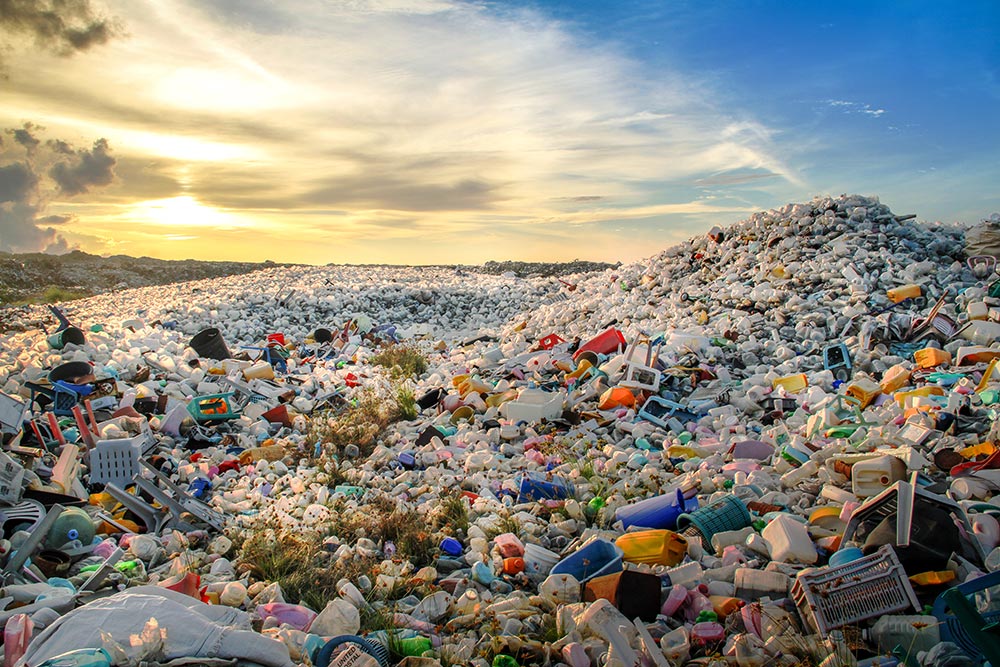Jeff Dondero, 70, is a former Marin County resident and journalist who wrote for the “Pacific Sun,” the “Marin Independent Journal” and other papers in the 1970s. He now lives in Rohnert Park.
“I probably worked for every suburban paper in Marin County,” he says in an interview with the ‘Pacific Sun.’ Along the way he became interested in green construction and sustainability issues. He published “The Energy Wise Home” and “The Energy Wise Workplace” in 2017. He takes on America’s trash problem in “Throwaway Nation: The Ugly Truth About American Garbage,” published this year by Rowman & Littlefield.
“We’re the first generation that’s literally burying ourselves in our own crap,” he says of his fellow baby boomers. An avid sailor, he says our trash is piling up in the oceans, too. “You can’t go anywhere on the ocean without seeing our garbage.”
And human refuse doesn’t stop on earth.
As he writes in “Throwaway Nation,” space itself is now cluttered with our trash. The moon alone has 400,000 pounds of trash on it, and space junk abounds in the outer atmosphere, putting what Dondero sees as the imminent space tourism industry on a collision course with interstellar trash.
He paints a grim picture, but holds out hope that the same technological savvy and push for profit that created these mountains of trash will convert our waste into new resources.
“We have to plan, but we’re trying to catch up from decades of abuse,” he says. “It’s everybody’s responsibility.”—Stett Holbrook
Excerpts from Throwaway Nation, the Ugly Truth About American Garbage
If we were guests, we would have been asked to leave. As proprietors, our property value would have plummeted. As groundskeepers, we would have been fired. Just because we are the dominant species doesn’t mean we own the place and can be passive guests. We have the responsibility to leave it for those who come next. We have influenced conditions on this planet throughout its history—and objectively not for the better. It seems that it wasn’t enough to befoul just the planet; now we are also leaving our left-behinds in space and on other planets.
Space Junk
Thank God man cannot fly and lay waste to the sky as well as the earth. — Henry David Thoreau.
The good news is that no one has ever been injured or killed due to falling space junk. The bad news is that unless we clean up our extraterrestrial neighborhood, space travel, especially in orbit, is very likely going to be deadly. In space are thousands of collisions with space junk waiting to happen.
We are responsible for the mess of “orbital debris” that we left by accident, neglect, or design, and dumped on the moon and Mars—our newest extraterrestrial “spacefills.” Humans have a real nasty habit of discarding their stuff wherever they go. According to NASA, hundreds of millions of pieces of space debris are now floating through our region of the solar system.
Elon Musk is the newest name in contributing to the junkyard of space. He may be a way-cool space entrepreneur, but he’s debuting in space as a high-class litterer, contributing to the accumulation of space scrap in the next phase in Earth’s interplanetary journeys. In 2018, SpaceX, Musk’s company, launched a cherry-red Tesla Roadster and its dummy “driver,” Star Man, on its Falcon Heavy rocket, blasting David Bowie’s “Life on Mars” on its way to Mars orbit. We don’t mean to be a spoil-space-sport about this, but come on—the car isn’t exactly going to be “draggin’ the cosmos” and doing hot laps on the red planet.
The moon, our next-door neighbor, has felt the negligent hand of humans with our various detritus, including astronaut poop and barf bags. This, of course, has conservationists very concerned about the moon’s protection should further trips there be undertaken. At present Tranquility Base is still tranquil, as there is not any wind or rain up there to damage or blow things around or, at the moment, any more tourists to leave things behind. But it looks as if not much thought has been given to protection of our rocky satellite or laws enacted regarding its protection. As yet, only California and New Mexico have recognized the moon as an international historic sight, and for now, it isn’t recognized as a historic landmark or considered a World Heritage Site by the United Nations Educational, Scientific and Cultural Organization (UNESCO).
In 2009, NASA and The Defense Advanced Research Projects Agency (DARPA), an arm of the U.S. Department of Defense responsible for the development of emerging technologies, convened a space junk wake-up call. The team took a hard look at the issues and challenges of de-cluttering space of human-made orbital rubble.
But whatever the method, it’s time we started to clean up our act. Maybe that’s why we haven’t had direct contact with any extraterrestrial beings—they just can’t stand our mess.
Fish to Farm to Table to Trash
People don’t know whether to be astonished, ashamed or amused when it comes to the magnitude of food that Americans throw away. No other country in the history of the world has the ability to raise, produce, eat and toss out as much as we do.
Mothers still shake fingers at their children admonishing fussy eaters, “Just think of all the children in the world that are starving and would love this food you’re wasting.” Of course, most of us answered, “OK, send it to them.” Fact is, mom was right. And so were we, kind of, because we export more food than any other nation on Earth, more than $135 billion each year.
All levels of the food system are riddled with waste—farming, harvesting, transportation, packaging, wholesale and retail marketing, and finally our tables. Food waste levels are 20 to 25 percent of manufacturing, 15 to 20 percent of retail sales and 55 to 65 percent from consumers.
The truth is there’s enough food to feed every single person in America if we can help farmers, manufacturers and retailers get the food to the people who need it. That’s why the Feeding America network and its partners work with farmers and food companies to rescue food and deliver it to families facing hunger. Things could be changing on the food waste front, with the US Department of Agriculture (USDA) and the EPA setting the first-ever national food waste reduction goal, aimed at cutting national food waste in half by 2030.
Food facts and figures:
- Less than 1 percent of pesticides applied to crops reach the pest, the rest poison the ecosystem. Each year 25 million people are poisoned by pesticides in less-developed countries and over 20,000 die.
- One-third of the world’s fish catch and more than one-third of the world’s total grain output are fed to livestock—the most wasteful way to produce protein. It takes 175 gallons of water to produce an eight-ounce soy burger, and a whopping 450 gallons of water to produce a quarter-pound beef burger. [Grassfed beef, however, is far less water intensive].
- About 50 percent more food is wasted today per person than in the mid-1970s and more than two-thirds of the food we throw away is edible.
- Food is so cheap and available to most families that they throw out up to 25 percent of their food and beverages. This can cost the average family between $1,365 and $2,275 annually.
- A study by the University of Arizona found that 14 percent of the food trashed in America was not even unpackaged.
- A 20 percent reduction in food waste would be enough to feed 25 million Americans. Five percent of Americans’ leftovers could feed four million people for one day.
- Between 40 and 50 percent of wasted food uses up 25 percent of all fresh water in the United States.
- It costs $750 million to dispose of food thrown away annually.
Trendy to Trash
It’s high irony that the industries that produce haute couture; flawlessly colored and perfectly cosmetized faces and hair; and impeccably lighted, posed, and glossy high-fashion photos are also industries whose dirty secrets are hidden in clothes closets.
The fashion industry (including cosmetics) is the second-dirtiest business in the world, right after oil and petroleum products, with rampant production schedules and unconscionable recycle rates. A lot of power is needed to produce 150 billion-plus articles of clothing each year and most of the countries where those garments are produced use coal for their energy source. This helps to explain why the apparel industry is responsible for 10 percent of all carbon waste emissions globally. According to a 2013 report cited by Esquire magazine, the global apparel industry produced enough garments in 2010 to provide 20 new articles of clothing for every person on the planet.
The incredible 500 percent increase in worldwide clothes production since the 1990s is due largely to teenagers and trendy “fast fashion.” Today, the fashion industry and the culture of throwaway clothing it has inspired have produced some startling statistics. The average American throws away more than 82 pounds of textiles per year. We’re buying more than 80 billion new items of clothing each year in this country, much of which is not being reused, recycled or repurposed.
Thinking Inside and Outside the Box
Who hasn’t experienced “wrapping rage” trying to dislodge some desired doodad from the bondage of a heat-sealed plastic blister pack clamshell or other encasement? What’s worse is that over-packaging mania accounts for a third of the waste thrown away in the United States.
And, less than 14 percent of plastic packaging, which is the fastest-growing form of packaging, gets recycled. Packaging adds twenty-nine million tons of non-biodegradable waste to landfills every year.
Americans use 100 billion plastic bags a year, which require 12 million barrels of oil to manufacture. Of all the plastic problems people face, the aggravating single-use plastic bag is the baddie. There was recently a kind of a test case for bagging the problem in California. The state has been in the lead for many ecological causes in the past. Proposition 67, a plastic bag law, was passed in 2016.
And the ban seems to be working. In San Jose the storm drain systems are 89 percent cleaner and streets and creeks have been reported as 60 percent cleaner. In Los Angeles County, the ban resulted in a 94 percent reduction in single-use bag use. In Alameda County, officials reported finding 433 plastic bags, compared to 4,357 in 2010. Monterey County reported even better news, with volunteers discovering only 43 plastic bags while performing their clean-up efforts, compared to 2,494 in 2010.
So, either people are so cheap that they’re using fewer bags because they have to buy them, or they’re getting the message about plastic pollution, or a little of both.
Then there’s the question of recyclability. Plastic juice pouches and drink boxes are generally not recyclable. The 1.4 billion Capri Sun pouches thrown away every year laid end-to-end would reach nearly halfway to the moon. NRDC joined the Make It, Take It campaign (a coalition of organizations devoted to waste recycling and resource conservation) to ask companies like Kraft, which produces and distributes Capri Sun, to use recyclable, reusable or compostable packages for beverages. They have made comments about an effort to recycle, but when asked if they plan to improve their packages or efforts to improve the sustainability of their product, CapriSun declined to comment.
Eight in 10 Americans are now shopping online, accounting for about 10 percent of all retail sales, and just about all products arrive in cardboard boxes.
Every day at the Recology plant in San Francisco, approximately 625 tons of recyclables, including more than one hundred tons of cardboard, are collected, and the amount of plastic film has increased for eleven consecutive years. Plastic film recycling—a category that includes flexible product wraps, bags, and commercial stretch film made primarily from polyethylene (PE)—has increased nearly 84 percent since the first report was issued in 2005.
China, our best customer for garbage, is setting new limits on the contamination it will allow in mixed paper bales that American trash companies ship for recycling. “They’ve started getting more rigorous, even tearing open bales at customs,” said Chaz Miller, policy director for the National Waste & Recycling Association. Because the income from exporting our garbage to China often subsidizes the cost of some neighborhood garbage collection programs, taking less of America’s used paper will cause our bills to collect, recycle, or dispose of it, to rise.
And guess what—many of the items we order online are made in China and come in recycled cardboard boxes from paper material bought from the United States.
Opening Pandora’s Pharmacy
There’s a persistent and pervasive, high-priced illness in America today. It’s the overly expensive, overly prescribed and incredibly wasteful amount of American medicine made available to the public under and over the counter, in concert with doctors and America’s big pharma. It’s hand in hand in glove with one of the worst effects of modern medical technology—the belief that whatever ails us, taking a pill will kill it no matter the cost or waste.
The average American takes about 12 medications annually compared to seven 20 years ago. Back then, spending on drugs totaled about 5 percent of the total US health care costs, now it’s more like 17 percent. Spending on prescription medications has increased by a knockout of $200 billion in two decades.
We take a total of 2.9 billion trips annually to purchase retail over-the-counter (OTC) products. On average, U.S. households spend about $338 per year on OTC products. This amounts to tens of billions of dollars spent on vitamins, supplements, diet pills, cold cures, herbal remedies and other medicaments—providing incredible economic benefits to the companies that manufacture them.
Part of the growth of the almost half-trillion-dollar medical industry was brought about by waste—both in over-prescribing by the pharmaceutical and medical industry and in the discarding of medicine by consumers. Lamentably, methods of drug waste disposal are causing a major health hazard. Consumers aren’t the only ones tossing their drugs down the drain or in the garbage. The Associated Press estimates hospitals and long-term medical care institutions across the United States dump 250 million pounds of pharmacologically active drugs that can have severe effects on humans and wildlife directly into public sewer systems each year.
A study published in the BMJ concluded Medicare and private insurers, as well as patients, pay companies about $1.8 billion a year for medications that are thrown away—that’s 10 percent of drug companies’ projected 2016 revenue of $18 billion. Add another $1 billion to doctors and hospitals as price markups on those discarded medications. Those profits would not exist if companies sold vial sizes more in line with the needs of patients, researchers suggest, and the problem is not unique to cancer drugs.








